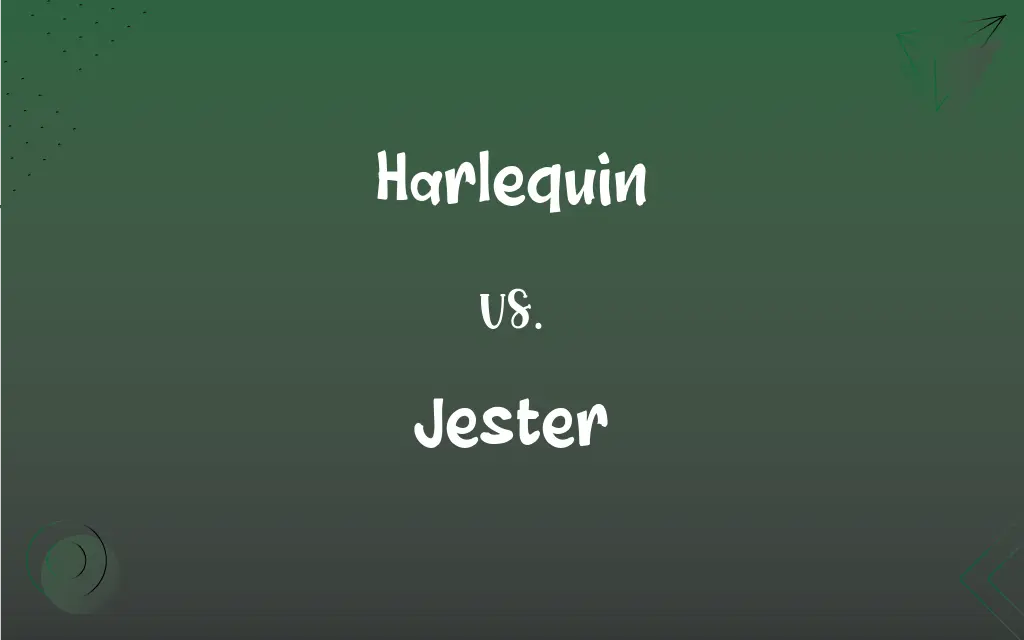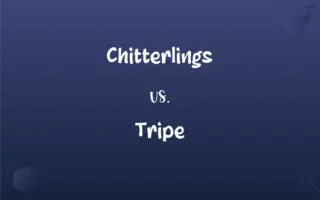Harlequin vs. Jester: What's the Difference?
By Aimie Carlson & Janet White || Updated on March 4, 2024
Harlequin is a comic servant character from Italian Commedia dell'arte, known for his checkered costume, while a jester is a historical entertainer for royalty, often wearing a motley outfit with a fool's cap.

Key Differences
The Harlequin character originates from the Italian Commedia dell'arte, a form of theatrical entertainment that flourished in Italy from the 16th to the 18th century. Harlequin is characterized by his nimble and acrobatic movements, as well as his distinctive checkered costume, usually in diamond-shaped patterns. Jesters, on the other hand, were real historical figures who entertained courts and royalty in medieval and Renaissance Europe. They were known for their witty humor, storytelling, music, and acrobatic performances, serving not only to amuse but sometimes to offer advice or criticism under the guise of comedy.
While Harlequin is a specific character with a set role within the stories of Commedia dell'arte, jesters were actual entertainers employed by nobles and monarchs across various cultures and time periods. Harlequin's performances were scripted as part of a larger narrative, whereas jesters improvised their acts to suit the occasion, audience, or their own talents.
Harlequin's role in Commedia dell'arte often revolves around themes of love, trickery, and the inversion of social norms, reflecting the comedic and sometimes satirical nature of the genre. His character is emblematic of the clever servant archetype, using physical comedy and wit to navigate complex social situations. Jesters, conversely, could navigate the social hierarchies of the courts they served, using humor to comment on politics, society, and even the monarch themselves albeit carefully.
Comparison Chart
Origin
Italian Commedia dell'arte.
Medieval and Renaissance European courts.
Role
Comic servant or trickster.
Court entertainer and advisor.
ADVERTISEMENT
Costume
Checkered, diamond-patterned outfit.
Motley outfit with a fool's cap and bauble.
Performance
Scripted theatrical entertainment.
Improvised humor, storytelling, music.
Themes
Love, trickery, social inversion.
Humor, social and political commentary.
Historical Basis
Theatrical character.
Real historical occupation.
Social Function
Entertainment within a narrative framework.
Entertainment and critique in royal courts.
ADVERTISEMENT
Characterization
Fixed persona within Commedia dell'arte.
Varied, depending on the individual's skills and personality.
Harlequin and Jester Definitions
Harlequin
Performs in a theatrical ensemble.
In the troupe, Harlequin's character added a dynamic element of humor and surprise.
Jester
Known for wearing a motley outfit and fool's cap.
The jester's colorful attire jingled with every jest.
Harlequin
Symbolizes the clever servant archetype.
As Harlequin, his antics outsmarted his masters with ease.
Jester
Often served as a social and political commentator.
The jester's tales cleverly critiqued court politics under the guise of humor.
Harlequin
Engages in comedic plots and schemes.
Harlequin devised a clever plan to win over his love interest.
Jester
A historical court entertainer.
The jester amused the royal court with his witty jokes.
Harlequin
Harlequin A conventional buffoon of the commedia dell'arte, traditionally presented in a mask and parti-colored tights.
Jester
Performed a variety of acts, from music to mockery.
The jester sang a humorous ballad that had everyone laughing.
Harlequin
A clown; a buffoon.
Jester
Occupied a unique position to speak truth to power.
The jester was the only one who could mock the king without fear of retribution.
Harlequin
Having a pattern of brightly colored diamond shapes.
Jester
One given to jesting.
Harlequin
A pantomime fool, typically dressed in colorful checkered clothes.
Jester
A fool or buffoon at medieval courts.
Harlequin
A greenish-chartreuse color.
Jester
One who jests, jokes or teases.
Harlequin
(informal) A harlequin duck.
Jester
A person in colourful garb and fool's cap who amused a medieval and early modern royal or noble court.
Harlequin
(entomology) Any of various riodinid butterflies of the genera Taxila and Praetaxila.
Jester
Any of various nymphalid butterflies of the Southeast Asian genus Symbrenthia.
Harlequin
Brightly colored, especially in a pattern like that of a harlequin clown's clothes.
Jester
A buffoon; a merry-andrew; a court fool.
This . . . was Yorick's skull, the king's jester.
Dressed in the motley garb that jesters wear.
Harlequin
Of a greenish-chartreuse color.
Jester
A person addicted to jesting, or to indulgence in light and amusing talk.
He ambled up and downWith shallow jesters.
Harlequin
(transitive) To remove or conjure away, as if by a harlequin's trick.
Jester
A professional clown employed to entertain a king or nobleman in the middle ages
Harlequin
(intransitive) To make sport by playing ludicrous tricks.
Harlequin
A buffoon, dressed in party-colored clothes, who plays tricks, often without speaking, to divert the bystanders or an audience; a merry-andrew; originally, a droll rogue of Italian comedy.
As dumb harlequin is exhibited in our theaters.
Harlequin
To play the droll; to make sport by playing ludicrous tricks.
Harlequin
To remove or conjure away, as by a harlequin's trick.
And kitten, if the humor hitHas harlequined away the fit.
Harlequin
A clown or buffoon (after the Harlequin character in the commedia dell'arte)
Harlequin
Variegate with spots or marks;
His face was harlequined with patches
Harlequin
A Commedia dell'arte character known for agility and cunning.
The actor's portrayal of Harlequin captivated the audience with acrobatic feats.
Harlequin
Wears a distinctive checkered costume.
The Harlequin's costume shimmered with vibrant, diamond-shaped colors.
FAQs
Were jesters only found in European courts?
While the term "jester" is often associated with European courts, similar figures existed in various cultures around the world, serving roles akin to jesters in entertaining and advising their rulers.
Can a Jester be considered a type of Harlequin?
No, a jester is not a type of Harlequin. They originate from different cultural and historical contexts, with distinct roles and representations in entertainment.
Did Harlequins ever exist in real life?
While Harlequin is a theatrical character, actors have historically portrayed him in Commedia dell'arte performances, making him a significant figure in theatrical history rather than a real-life occupation.
How did Harlequins and jesters influence modern entertainment?
Harlequins influenced physical comedy, acrobatics in theatre, and the archetype of the clever servant, while jesters contributed to the tradition of satire, political comedy, and the role of the comedian as a social commentator.
How are Harlequins and jesters portrayed in literature and film?
Both are frequently depicted in literature and film, with Harlequins appearing as whimsical or mysterious figures rooted in their Commedia dell'arte origins, and jesters as wise fools or critical voices within historical and fantasy settings.
What is the main difference between a Harlequin and a Jester?
The main difference is that Harlequin is a fictional character from Commedia dell'arte known for his physical comedy and checkered costume, while a jester was a real court entertainer with a broader role, including humor, music, and social commentary.
Is the Harlequin's costume symbolic?
Yes, the Harlequin's checkered costume is symbolic of his multifaceted nature—part trickster, part lover, and always a servant, embodying the complexity of human emotions and social roles.
What skills were required to be a jester?
Jesters needed a wide range of talents, including musical ability, storytelling, acrobatics, and most importantly, the wit to entertain and subtly critique without offending their patrons.
Are there female equivalents to Harlequins and jesters?
In Commedia dell'arte, female characters had roles similar to Harlequin in terms of cleverness and agility, though not directly called Harlequins. Historical records of female jesters are rarer but they did exist, serving similar functions as their male counterparts.
How has the image of the jester influenced modern clowns?
The jester's persona, particularly their role as entertainers who use humor to reflect on human nature and societal issues, has significantly influenced the evolution of modern clown characters in circuses and theater.
Did jesters have any special privileges?
Yes, jesters were often granted significant leeway to speak freely and critique the monarchy and nobility, a privilege not extended to others in the court due to their role as entertainers and fools.
Has the concept of the Harlequin changed over time?
Yes, the portrayal of Harlequin has evolved, adapting to different cultural contexts and theatrical styles, but his essence as a clever, agile, and romantic figure remains a constant in the arts.
Can Harlequin and Jester costumes be found in modern celebrations?
Yes, both Harlequin and Jester costumes are popular in various festivities, including Mardi Gras and Carnival, symbolizing the enduring appeal of these characters in cultural celebrations.
How did the public perceive Harlequins and jesters?
Harlequins were admired for their agility, wit, and the escapism their performances offered, while jesters were appreciated for their humor, insight, and the unique role they played in courtly life.
What distinguishes a Harlequin's performance from a jester's act?
A Harlequin's performance is typically characterized by physical comedy, acrobatics, and silent storytelling within a scripted play, whereas a jester's act involved a broader range of improvisational speech, song, and interaction with the audience.
Were jesters respected members of the court?
Yes, jesters were often respected and valued for their intelligence, wit, and the unique perspective they offered, enjoying a certain status that allowed them close proximity to power.
Why is the Harlequin's costume checkered?
The checkered pattern of the Harlequin's costume represents his complex, multifaceted nature and his role as a dynamic, unpredictable force within Commedia dell'arte.
What role did jesters play in medieval society beyond entertainment?
Beyond entertainment, jesters served as advisors, used humor to defuse tense situations, and provided a means for critiquing societal norms and politics, often conveying messages that others couldn't.
Did jesters travel, or were they attached to a single court?
While many jesters were attached to a particular court, some traveled between courts or performed publicly, especially those who were part of medieval and Renaissance performance troupes.
How do the roles of Harlequins and jesters reflect the societies they originated from?
The roles of Harlequins and jesters mirror the social hierarchies, cultural values, and attitudes towards humor and satire in their respective societies, showcasing the universal need for entertainment, critique, and reflection on the human condition.
About Author
Written by
Aimie CarlsonAimie Carlson, holding a master's degree in English literature, is a fervent English language enthusiast. She lends her writing talents to Difference Wiki, a prominent website that specializes in comparisons, offering readers insightful analyses that both captivate and inform.
Co-written by
Janet WhiteJanet White has been an esteemed writer and blogger for Difference Wiki. Holding a Master's degree in Science and Medical Journalism from the prestigious Boston University, she has consistently demonstrated her expertise and passion for her field. When she's not immersed in her work, Janet relishes her time exercising, delving into a good book, and cherishing moments with friends and family.
































































